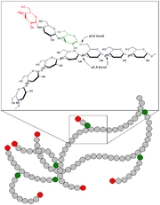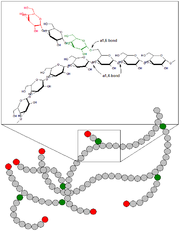
Glycogenolysis
Encyclopedia

Glycogen
Glycogen is a molecule that serves as the secondary long-term energy storage in animal and fungal cells, with the primary energy stores being held in adipose tissue...
polymers to glucose
Glucose
Glucose is a simple sugar and an important carbohydrate in biology. Cells use it as the primary source of energy and a metabolic intermediate...
monomers. Glycogen is catabolized
Catabolism
Catabolism is the set of metabolic pathways that break down molecules into smaller units and release energy. In catabolism, large molecules such as polysaccharides, lipids, nucleic acids and proteins are broken down into smaller units such as monosaccharides, fatty acids, nucleotides, and amino...
by removal of a glucose
Glucose
Glucose is a simple sugar and an important carbohydrate in biology. Cells use it as the primary source of energy and a metabolic intermediate...
monomer through cleavage with inorganic phosphate
Phosphate
A phosphate, an inorganic chemical, is a salt of phosphoric acid. In organic chemistry, a phosphate, or organophosphate, is an ester of phosphoric acid. Organic phosphates are important in biochemistry and biogeochemistry or ecology. Inorganic phosphates are mined to obtain phosphorus for use in...
to produce glucose-1-phosphate
Glucose-1-phosphate
Glucose 1-phosphate is a glucose molecule with a phosphate group on the 1'-carbon.-Catabolic:In glycogenolysis, it is the direct product of the reaction in which glycogen phosphorylase cleaves off a molecule of glucose from a greater glycogen structure.To be utilized in cellular catabolism it must...
. This derivative of glucose is then converted to glucose-6-phosphate
Glucose-6-phosphate
Glucose 6-phosphate is glucose sugar phosphorylated on carbon 6. This compound is very common in cells as the vast majority of glucose entering a cell will become phosphorylated in this way....
, an intermediate in glycolysis
Glycolysis
Glycolysis is the metabolic pathway that converts glucose C6H12O6, into pyruvate, CH3COCOO− + H+...
.
The hormones glucagon
Glucagon
Glucagon, a hormone secreted by the pancreas, raises blood glucose levels. Its effect is opposite that of insulin, which lowers blood glucose levels. The pancreas releases glucagon when blood sugar levels fall too low. Glucagon causes the liver to convert stored glycogen into glucose, which is...
and epinephrine
Epinephrine
Epinephrine is a hormone and a neurotransmitter. It increases heart rate, constricts blood vessels, dilates air passages and participates in the fight-or-flight response of the sympathetic nervous system. In chemical terms, adrenaline is one of a group of monoamines called the catecholamines...
stimulate glycogenolysis.
Function
Glycogenolysis takes place in the muscle and liver tissues, where glycogen is stored, as a hormonal response to epinephrineEpinephrine
Epinephrine is a hormone and a neurotransmitter. It increases heart rate, constricts blood vessels, dilates air passages and participates in the fight-or-flight response of the sympathetic nervous system. In chemical terms, adrenaline is one of a group of monoamines called the catecholamines...
(e.g., adrenergic stimulation) and/or glucagon
Glucagon
Glucagon, a hormone secreted by the pancreas, raises blood glucose levels. Its effect is opposite that of insulin, which lowers blood glucose levels. The pancreas releases glucagon when blood sugar levels fall too low. Glucagon causes the liver to convert stored glycogen into glucose, which is...
, a pancreatic peptide triggered by low blood glucose
Glucose
Glucose is a simple sugar and an important carbohydrate in biology. Cells use it as the primary source of energy and a metabolic intermediate...
concentrations, and produced in the alpha cells of the islets of Langerhans
Islets of Langerhans
The islets of Langerhans are the regions of the pancreas that contain its endocrine cells. Discovered in 1869 by German pathological anatomist Paul Langerhans at the age of 22, the islets of Langerhans constitute approximately 1 to 2% of the mass of the pancreas...
.
- LiverLiverThe liver is a vital organ present in vertebrates and some other animals. It has a wide range of functions, including detoxification, protein synthesis, and production of biochemicals necessary for digestion...
(hepatic) cells can consume the glucose-6-phosphate in glycolysisGlycolysisGlycolysis is the metabolic pathway that converts glucose C6H12O6, into pyruvate, CH3COCOO− + H+...
or remove the phosphate group using the enzyme glucose-6-phosphatase and release the free glucose into the bloodstream for uptake by other cells.
- MuscleMuscleMuscle is a contractile tissue of animals and is derived from the mesodermal layer of embryonic germ cells. Muscle cells contain contractile filaments that move past each other and change the size of the cell. They are classified as skeletal, cardiac, or smooth muscles. Their function is to...
cells in humans do not possess glucose-6-phosphatase and, hence, will not release glucose, but instead use the glucose-6-phosphate in glycolysisGlycolysisGlycolysis is the metabolic pathway that converts glucose C6H12O6, into pyruvate, CH3COCOO− + H+...
.
Clinical significance
Parenteral (intravenous) administration of glucagon is a common human medical intervention in diabetic emergencies when sugar cannot be given orally. It can also be administered intramuscularly.First step
The overall reaction for the 1st step is:Glycogen (n residues) + Pi <-----> Glycogen (n-1 residues)+ G1P
Here, glycogen phosphorylase
Glycogen phosphorylase
Glycogen phosphorylase is one of the phosphorylase enzymes . Glycogen phosphorylase catalyzes the rate-limiting step in the degradation of glycogen in animals by releasing glucose-1-phosphate from the terminal alpha-1,4-glycosidic bond...
cleaves the bond at the 1 position by substitution of a phosphoryl group. It breaks down glucose polymer at α-1-4 linkages until 4 linked glucoses are left on the branch. (Glycogen phosphorylase
Glycogen phosphorylase
Glycogen phosphorylase is one of the phosphorylase enzymes . Glycogen phosphorylase catalyzes the rate-limiting step in the degradation of glycogen in animals by releasing glucose-1-phosphate from the terminal alpha-1,4-glycosidic bond...
(EC 2.4.1.1) can be used as a marker enzyme to determine glycogen breakdown. )
Second step
The second step involves the enzyme [α[1→4]→α[1→4] glucan transferase]/debranching enzyme, which transfers the three remaining glucose units to another 1,4 terminal of glycogen, which exposes the α[1→6] branching point. The final action of this enzyme is the hydrolysis of the remaining glucose attached at the α[1→6] branch point, which gives one free glucose molecule. This is the only case in which a glycogen metabolite is not glucose-1-phosphate. These glucan transferase and debranching enzyme activities are from two separate catalytic sites on the same protein.Third step
The third and last stage converts G1P (glucose-1-phosphate) to G6P (glucose-6-phosphate) through the enzyme phosphoglucomutasePhosphoglucomutase
Phosphoglucomutase is an enzyme that transfers a phosphate group on an α-D-glucose monomer from the 1' to the 6' position in the forward direction or the 6' to the 1' position in the reverse direction....
.
Regulation
The key regulatory enzyme of the process of glycogenolysis is glycogen phosphorylaseGlycogen phosphorylase
Glycogen phosphorylase is one of the phosphorylase enzymes . Glycogen phosphorylase catalyzes the rate-limiting step in the degradation of glycogen in animals by releasing glucose-1-phosphate from the terminal alpha-1,4-glycosidic bond...
:
- Phosphorylation --> activation
- Dephosphorylation --> inhibition

